In what kind of chair should the CEO of Goldman Sachs sit?
Before you answer, consider Matt Taibbi's famous description of the company:
The world's most powerful investment bank is a great vampire squid wrapped around the face of humanity, relentlessly jamming its blood funnel into anything that smells like money.
And now, with that description in mind, behold the side and rear views of the first chair truly fit to serve as the throne from which Goldman Sachs' CEO manages his company's business! (HT: Core77)
 |
 |
And now, an isometric view from a rear perspective, just to get more of the full effect of the chair's design:

The chair was designed by Maximo Riera, who called it an "Octopus Chair". However, given the color and the vampire squid's practice of hollowing out its prey to use as camouflage in going about its business, we believe he misidentified it. It's clearly a Vampire Squid!
If you're intrigued by the idea of getting this kind of chair for yourself, know that there can only be one true Vampire Squid chair, and it can only belong to the CEO of Goldman Sachs. You might have better luck in acquiring this alternate choice, now available from Amazon....
Labels: none really
Mark Perry put up the public vs private school teacher income data for 2007-08 in a table format. We took that data and put it into graphical form, then added the median income data for full-time, year-round workers from the U.S. Census just to compare. The results are below:

Feel free to use the tool below (originally featured here) to convert the "teacher pay" into its equivalent "full-time, year round" value! We've set it up with the default value for an average public school teacher with 5 to 9 years of experience:
Now, keep in mind that doesn't take into account the average value of the benefits earned by any of these parties! Politifact reports the following for public school teachers in the state of Wisconsin:
The latest figures available are for 2009-2010, according to a state Department of Public Instruction spokesman. Public school teachers in Wisconsin earned an average of $49,816 in salary plus $25,325 in benefits for a total of $75,141.
We see in our chart above that a public school teacher with 5 to 9 years of experience made $49,120 during the 2007-08 school year, which is 98.6% of what the average Wisconsin public school teacher made in the 2009-10 school year, so the figures for benefits and total compensation for teachers nationwide should be nearly equal, assuming Wisconsin is nearly average.
By contrast, the average benefits earned by full-time, year-round employees in private industries in the United States in 2008 is $9,881 (the difference between an average total compensation of $62,899 and an average annual salary or wage of $51,187). For private sector employees in the Education Services industry, the average benefits earned is $7,271 (the difference between an average total compensation of $46,397 and an average annual salary or wage of $39,126).
Overall, these figures track very well with the data shown in the chart for teachers with 5 to 9 years of experience. As such, we can project that the total compensation for an average private school teacher will add up to roughly $45,381, while an average public school teacher receives annual compensation worth $74,445. That's 164% of what a similarly experienced private school teacher doing the same job would earn.
It would then appear that public school teaching is quite the racket, as public school teachers get paid a very large premium to teach, even though they don't perform any better than private school teachers do in educating American children.
Data Sources
U.S. Department of Education. National Center for Education Statistics. Digest of Education Statistics. Table 75. Average salaries for full-time teachers in public and private elementary and secondary schools, by selected characteristics: 2007-08.
U.S. Census Bureau. Current Population Survey (CPS). Annual Social and Economic (ASEC) Supplement. PINC-01. Selected Characteristics of People 15 Years Old and Over by Total Money Income in 2008, Work Experience in 2008, Race, Hispanic Origin, and Sex.
U.S. Census Bureau. Statistical Abstract of the United States: 2011. Table 642. Annual Total Compensation and Wages and Salary Accruals Per Full-Time Equivalent Employee by Industry: 2000 to 2008. Accessed 29 March 2011.
Politifact. U.S. Sen. Rand Paul Says the Average Public School Teacher in Wisconsin Makes $89,000 in Salary and Benefits. Accessed 29 March 2011.
U.S. Department of Education. National Assessment of Education Progress. The Nation's Report Card: Comparing Private Schools and Public Schools Using Hierarchical Linear Modeling. July 2006.

GDP, or if we spell it out, Gross Domestic Product, is the primary measure the economic activity within a nation. Mathematically, it is the sum of all consumer and government spending on goods and services, business capital investment spending and the value of the nation's net exports (exports minus imports) for all the goods and services produced within a nation's borders.
When most people think of these things, they think of tangible items. As consumers, many can see themselves buying a cup of coffee or getting a haircut. As taxpayers, you can see the government buying airplanes or contracting to fix a pothole. As business owners, or just people who work at businesses, you can see the business making capital investments, such as buying a computer or expanding a facility. Where net exports are concerned, you can see container ships in ports being unloaded and reloaded.
But did you ever think that one of the United States' fastest growing exports might not be something you can see and touch? The New Republic's William Galston writes (HT: Craig Newmark), emphasis ours:
Several days ago, the Congressional Budget Office (CBO) released its preliminary analysis of the fiscal impact of the president’s FY2012 budget proposal. Its findings were not pretty. In no year between now and 2021 would deficits fall below 4 percent of GDP. Over the next decade, enacting the president’s proposal would create deficits totaling $9.5 trillion, $2.7 trillion more than the cumulative deficit in CBO’s baseline budget. Federal debt held by the public would double from $10.4 trillion to $20.8 trillion, 87 percent of GDP, and annual interest on the debt would rise from 1.4 percent of GDP to nearly 4 percent. Even if the share of the debt held by foreign investors and governments does not increase over the next decade, CBO’s projection suggests that we’ll be shipping fully 2 percent of our GDP (almost $500 billion) overseas each year by the end of the decade, just to pay the interest on foreign holdings of U.S. government debt.
We wonder if the U.S. government's leaders have really considered what the consequences of continuing that kind of trade imbalance fueled by its excessive spending might be.
But the desire to continue that level of excessive spending might perhaps explain the real purposes behind President Obama's recent vacation/official visit to Brazil.
Here, the President traveled to Brazil for the stated purpose of promoting U.S. exports to the largest nation in South America to help create jobs in the U.S. But once there, he made it very clear that he was looking forward to importing more oil from Brazil, which has substantial oil reserves in deep waters off its coast.
Meanwhile, his administration has used its regulatory powers to inhibit U.S. offshore oil production, which is costing U.S. jobs.
That doesn't make sense, does it? The President's trade and energy policies would seem designed to lower both U.S. GDP and employment levels.
And that doesn't make sense, at least until you factor in what the President is really seeking to export to Brazil in this trade: U.S. government-issued debt.
As it happens, after China, the nation of Brazil has become the fastest growing foreign holder of U.S. government-issued debt during the past decade. In fact, it has grown from having U.S. debt holdings so insignificant among all foreign holders of the U.S. national debt that the U.S. Treasury didn't list the nation separately until 2002. As of the end of 2010, it owned 1 out of every 24 dollars of the U.S. national debt owned by foreign entities - an ownership share that will only grow thanks to the outcome of the President's trade mission.

Brazil has been able to rapidly grow its holdings of the U.S. national debt from virtually nothing to become the fifth largest foreign holder of that debt thanks to the United States' growing trade deficit with the South American nation. To balance the books of the international trade, Brazil has been making up the growing shortfall in what the U.S. exports to it through regular trade by buying up U.S. Treasury securities in growing amounts.
What the President would appear to be hoping to achieve in his apparent combined trade, energy and national debt policies is continued inflow of fiscal support for his excessively ambitious spending agenda, upon which his political position relies. Fiscal support that he also needs to help offset the power that the nation of China has gained over the U.S. through its U.S. government-issued debt holdings, which it demonstrated for the Obama administration in December 2010.
And thus, we find that President Obama's trip to Brazil was indeed all about American exports and jobs. It's just that America's exports aren't what you might have thought they were and the jobs being "created or saved" are those of his cronies and his own.
Labels: national debt, trade
Our regular readers know we periodically experiment with different ways of visualizing data. Today's experiment shows how the number of jobs paying wages or salaries above and below the federal minimum wage has changed in each year since 2006.
Here, we've adapted the candlestick charts used to communicate stock price changes over time to instead indicate the number of jobs that existed at various wage levels in 2006 with the actual number of jobs at the same reference wage levels in the years from 2006 through 2010.

In the chart above, the large purple bands indicate the actual number of employed individuals in the U.S. for each year shown. The black bands that appear either above or below the purple bands indicate the additional number of jobs that existed in 2006 that no longer existed in subsequent years, whether above the minimum wage level (indicated by the horizontal axis), or below it. We then added the numerical data above and below each band to indicate the relative change in the number of jobs either above or below the minimum wage line with respect to the levels recorded at the time-weighted1 indicated wage levels in 2006.
Here's what we see as we read the chart from left to right. 2007, the first year in which we have a federal minimum wage increase, saw 402,850 jobs lost from the U.S. economy below the time-weighted minimum wage level for that year, while the otherwise growing economy added 2,033,767 jobs above the minimum wage line. We know that the jobs below the minimum wage line were lost, rather than shifted above the line, because the number of employed teens and young adults, the individuals most likely to have jobs earning the minimum wage, declined significantly between 2006 and 2007.
In 2008, the economy added some 46,482 jobs above the time-weighted minimum wage line for that year, raising the total difference from 2006's job level above the federal minimum wage level to 2,080,249, but shed 1,128,832 jobs paying the federal minimum wage or less.
It's not until 2009 that we see the effects of the recession that was declared to have begun in December 2007, and specifically, the result of the bottom dropping out of the U.S. automotive industry in late 2008, affect the relative number of jobs that existed above the time-weighted federal minimum wage level. Here, 4,919,970 jobs paying more than the federal minimum wage were lost in 2009, bringing the total number of jobs paying more than the federal minimum wage to be 2,839,721 below the number of jobs paying more than the indicated time-weighted wage levels in 2006.
Meanwhile, 1,691,445 jobs continued to be shed below the federal minimum wage line for that year, which saw the official end of the recession in June 2009.
For 2010, we see that the number of jobs above the federal minimum wage line continued to decline to be 3,117,617 below the level for the indicated wage level of $7.25 per hour that would have been recorded in 2006. Likewise, 2,234,383 fewer Americans earned $7.25 or less per hour in 2010 than did in 2006.
1 For those years in which there was more than one level of the federal minimum wage, we must take into account the amount of time for which each minimum wage level applied during the year in estimating the number of people earning the federal minimum wage or less. We did that by adding together the number of people estimated to be earning the lower indicated wage in 2006 multiplied by the fraction of the year at which that lower minimum wage rate applied and the number of people estimated to be earning the higher indicated wage in 2006 multiplied by the fraction of the year at which it applied. This process is similar to how the Bureau of Labor Statistics "counts" the number of people earning the federal minimum wage or less in years in which the federal minimum wage is changed.
Labels: data visualization, minimum wage

Violent Crime Rates Across Canada
Source: Wikipedia
Yesterday, we suggested that Canada's apparent reduction of 1 homicide victim per 100,000 people that might be attributed to Canada's more restrictive gun control laws as compared to the United States was perhaps overstated.
The reason why that may be the case is because Canadian homicide offenders, who are less able to acquire firearms than U.S. homicide offenders, instead substitute the homicide methods of stabbing and beating in committing their murders.
Unlike shooting, these methods of murder require far more physical energy and time on the part of the offenders to kill their victims. So much so that it is more likely that the victims of these kinds of assaults might be able to survive the effort to kill them than a shooting victim is able to survive being shot.
One consequence of this greater difficulty for offenders to kill their victims through these kinds of violent assaults is that Canadian homicide statistics will not fully reflect how close some of the victims who survived being assaulted this way may have come to actually being killed.
To get a better sense of that factor, we returned to Canadian crime statistics and the U.S. WISQARS non-fatal injury database to compare each nation's relative levels of nonsexual and nonfatal assaults. The raw numbers we found for both nations are presented in our first chart.
Update 31 December 2012: We've corrected the numbers in the chart below, which previously only showed the combined total of Level 2 and Level 3 assaults in Canada, but all nonfatal, nonsexual assaults in the United States - the corrected version below shows the correct total for all nonfatal, nonsexual assaults in Canada in 2006. We've edited the remaining text and charts in the post to correspond to the corrected total assault numbers for Canada.
We next calculated the nonfatal assault rate per each 100,000 people for each country's entire population.
Update 31 December 2012: The original version is here, which was based on Canada's total nonfatal, nonsexual assault totals with a different estimate of Canada's population.
Since the WISQARS nonfatal injury data cannot be broken down by U.S. racial and ethnicity classifications as the database's fatal injury data can, this is as far as we can take the analysis. However, it is far enough to draw the conclusion that Canadians are assaulted at far higher rates than are Americans.
Overall, in 2006, there were 56,706 253,704 nonsexual assaults in Canada, or 770.23 802.23 per each 100,000 Canadians. In the U.S., there were 1,598,706 nonsexual assaults, or 535.41 per each 100,000 Americans. That's a nearly 235 266 for each 100,000 inhabitant difference between the two countries. That's a difference that would likely be even greater if we could drill down to count the number of assaults for the portion of the U.S. population that is most demographically similar to the Canadian population.
The only question then is what fraction of this much higher level of violent assault might account for victims being effectively "left for dead," but who instead manage to survive from the injuries inflicted upon them by their assailants?
We'll observe that it would only take 1 out of those 770 802 assaults per 100,000 Canadians to qualify as being that severe to fully make up the difference between Canadian and U.S. homicide rates per 100,000 inhabitants, at least among the portion of the U.S. population most demographically similar to Canada's population.
That very small fraction then suggests that Canada's gun control restrictions provide very little benefit to Canada's citizens. And if firearm possession should turn out to be a deterrent to physical assaults, Canadians may indeed be considerably worse off.
Image Credit: Wikipedia.
Data Sources
Juristat. Canadian Centre for Justice Statistics. Statistics Canada - Catalogue No. 85-002, Vol. 28, No. 7. Crime Statistics in Canada, 2007. Table 2. Selected Criminal Code Incidents, by most serious offence, Canada, 2006 and 2007. Accessed 23 March 2011.
U.S. Centers for Disease Control. WISQARS Nonfatal Injury Reports. Accessed 23 March 2011.
Labels: crime, data visualization
Now that we've established that the portion of the U.S. population most demographically similar to the population of Canada had a homicide rate of 2.87 per 100,000 people as compared to Canada's homicide rate of 1.94 per 100,000 people, we'll next look at how homicide victims in both countries were killed.
Our first chart shows what we found by tapping Canadian and U.S. statistics for the cause of death in homicides for the year 2006.

Right off the bat, we see major differences between the two countries in how the victims of homicides in both were killed. In the United States, the use of firearms accounts for just over half of all recorded homicides for the portion of the U.S. population most similar to the Canadian population, while in Canada, firearm-related homicides account for just shy of one-fourth of the total.
That observed outcome is likely due to Canada's much more restrictive gun laws, which greatly reduce the availability of handguns in that country. But while reducing the number of homicide deaths due to shootings in Canada, that same factor may very well account for the more brutal nature of murder in Canada as compared to the United States.
We observe that in the very much larger share of homicide deaths due to stabbing and to beatings in Canada as compared to the United States, which really is driven home when we look just at the non-firearm related homicide rates by method for 2006.

Once we omit firearm related deaths for both countries, we first see that the homicide rate per 100,000 people in both countries is nearly identical, so that confirms that the difference in firearm availability and use in both countries largely accounts for the difference in both countries' overall homicide rates.
The non-firearm homicide data however clearly confirms that murders in Canada are much more brutal than in the United States. Here, we find that the relative number of homicides involving stabbing as the cause of death in Canada is 167.4% greater than in the United States (0.67 homicides per 100,000 in Canada vs 0.40 homicides per 100,000 in the U.S.), while the number of homicides where the victims were beaten to death is 815.5% greater (0.38 homicides per 100,000 in Canada vs 0.05 homicides per 100,000 in the U.S.).

By contrast, we see that homicide deaths attributable to strangulation and burns or suffocation resulting from fire are approximately equal between both countries. That suggests that Canadian homicide offenders are specifically choosing to commit murder using the methods of stabbing and beating as substitutes for the firearms that are less available in Canada as compared to the U.S., much the same as individuals who successfully commit suicide in that nation do.
That in turn might also account for the overall difference in both countries observed homicide rate per 100,000 people. Because the homicide methods of stabbing and beating require substantially more physical energy and time on the part of the offender to inflict severe enough injuries to kill their victims as compared to the homicide method of shooting, it's likely that a large number of victims subjected to such an attack survive the murder attempt, given the greater difficulty the offender would have in killing them using these methods.
Since the victims subjected to these kinds of attacks weren't killed, they would therefore not add to Canada's homicide statistics. That possibility then would mean that the apparent savings of 1 homicide victim per 100,000 people that might be the apparent benefit of Canada's more restrictive gun laws as compared to the United States is overstated, as these statistics would not capture this particular dynamic.
Image Credit: Macleans.
Data Sources
Statistics Canada. CANSIM, Table 253-0002 and Homicide Survey, Canadian Centre for Justice Statistics. 26 October 2010. Accessed 20 March 2011.
U.S. Centers for Disease Control. WISQARS Injury Mortality Reports, 1999-2007. Accessed 20 March 2011.
Labels: crime, data visualization, demographics
How does the United States and Canada really compare to each other when it comes to the murderous impulses of each nation's population? And how does it really compare when we take the nations' primary racial and ethnic differences into account?
Let's answer the first question by tapping the data that applies for the year 2006, which in addition to being a pretty typical year for Canadian homicides, is also the most recent year in which Canada conducted a full census of its population. Our first chart reveals what we found when we dug into both Canadian and U.S. homicide statistics for that year:

In 2006, Canada saw 606 homicides, while the United States experienced 19,160. Let's next take the relative sizes of each nation's population into account by finding the number of homicides in each country for each 100,000 people.

We find then that Canada saw 1.94 homicides for each 100,000 people in its population, while the United States saw 6.42 homicides for each 100,000 people in its population. These figures represent an apples-to-oranges kind of comparison however, because they do not take the racial and ethnic makeup of each nation into account.
That's important because of the pattern we found in the United States for who kills who. Here, we found that the vast majority of the offenders in homicides are of the same race as their victims. Because the United States has very large minority populations (blacks and Hispanics) which are largely absent in Canada, we must exclude the numbers of homicides of black and Hispanic victims from the U.S. totals to make a much more accurate apples-to-apples kind of comparison of U.S. homicides with Canadian homicides.
The chart below reveals what we found when we compared Canadian homicides with the portions of the U.S. population that most closely resembles the Canadian population:

After comparing just the portions of the U.S. population that is most similar to the makeup of the Canadian population, we find that the U.S. sees approximately one additional homicide per 100,000 people than does Canada, with 2.87 homicides per 100,000 people compared to Canada's 1.94 homicides per 100,000 people.
To put that in perspective, if Canada had the demographically-adjusted U.S. homicide rate of 2.87 per 100,000, it would see an additional 292 homicides per year. Meanwhile, if the portion of the U.S. population that most closely resembles the demographics of the Canadian population had the Canadian homicide rate of 1.94 per 100,000, the United States would see roughly 2,180 fewer homicides per year in this portion of its total population.
Data Sources
Statistics Canada. CANSIM, Table 253-0002 and Homicide Survey, Canadian Centre for Justice Statistics. 26 October 2010. Accessed 20 March 2011.
U.S. Centers for Disease Control. WISQARS Injury Mortality Reports, 1999-2007. Accessed 20 March 2011.
Labels: crime, data visualization, demographics
We previously found that while we can get census-based data for both Canada and the United States that breaks down each nation's total population into various racial or ethnic components, we can't directly compare the two nation's populations using each nation's presented data because each uses a different system for classifying people within its population.
Here, Canada uses a geographic-based system for classifying the origins of its minority populations, while the U.S. uses race and Hispanic origin to classify its minority populations.
In order for us to be able to directly compare each nation's racial or ethnic diversity, we'll need to find a way to take that apples-to-oranges data and convert it into a form that makes an apples-to-apples comparison possible.
There are two ways we could do that conversion. We could either take the U.S. population data and mine through the data to dig out the geographic origin of the various minority populations, which would make it match the Canadian data. Or we could take the Canadian geographic-categorized data and work out how that might translate into the U.S.-based population classification system.
It then occurred to us that we could do literally do a translation of the Canadian minority population data into the relevant U.S. classifications using a "linguistic-mapping" approach!
Here, we recognize that the world can be divided into geographic regions according to the language families that have evolved over time, which in turn, also reflects the racial origin approach used by the U.S. to describe its resident population. The map below shows the geographic distribution of the world's major human language families:
This map allows up to directly translate Canada's geographic-based minority population classification system to the U.S. racial origin-based system. Here, the various green and yellow-shaded regions would be counted as "White" in the U.S. system, while people who's ancestral origin spans the red and pink-shaded regions and adjacent areas of the map would most likely be classified as "Asian", which addresses nearly all of the disputable categories. It's not perfect, but as they say, it's probably good enough for government work, or perhaps just the study of pharmacogenetics in ethnically diverse populations....
We can now then deal with the problem of hispanic origin. Here, Canada's remoteness from Spanish-speaking populations allows them to classify those with hispanic origin as originating from "Latin America", which makes it possible to specifically identify this demographic segment within the Canadian population. We should note that a similar logic would hold true for Canada's "black" population as well, which directly translates as well. We can then group all the other Canadian visible minority categories we haven't yet accounted for into a group called, well, "Other" for both nations to get our direct comparison.
Our next chart shows what we found in comparing the numbers of people using our approximation of the U.S. racial and Hispanic origin-based classification system:
What we find right off the bat is that the U.S. population is far greater than the Canadian population, and that the U.S. is comparatively far more racially and ethnically diverse, as we can really only see an Asian minority population in Canada, while we can see Black, Hispanic, Asian and Other populations in the United States.
But that reading may be an artifact of the scaling of the chart, which may not make it easy to see the relative share of these minority populations within Canada given its much smaller total population. To account for that scale issue, we next re-visualized the data as pie charts, specifically to compare the relative size of these minority populations within each nations' total population:
What we find is that Canada is far more racially homogeneous than the United States, with the "White" population representing 89.2% of the total population in Canada, while the same population category in the U.S. only represents 66.5% of the total population.
We also see that Canada has larger Asian population than does the United States, representing 6.7% of its population while accounting for 4.2% in the U.S. That situation is largely reversed for the "Other" category, which for the U.S. represents 2.3% of the total population, while "Other" covers just 0.7% of the Canadian population.
But it's Canada's comparative absence of black and Hispanic minority populations that really sets it apart from the United States. Here, blacks and Hispanics make up a combined 3.5% of the total Canadian population (2.0% for blacks and 1.5% for Hispanics), while the black and Hispanic population together represents 27.0% of the total U.S. population (12.23% black, 14.74% Hispanic, the latter figure encompassing all races).
Our next chart omits the black and Hispanic minority populations from both nations, while combining the "Asian" and "Other" categories, just to see how similar or different the two countries are after accounting for this major difference. Update 16 July 2017: Canada's "Visible Minority" categorization groups its "Aboriginal peoples" in with its "White" population. In the corrected chart below, we've matched that treatment with the U.S. data, transferring the populations of Native Americans, Alaskans, Hawaiians and Pacific Islanders from the "Asian and Other"
category to the "White" category in a similar fashion to Statistics Canada's methods.
Original version of chart here
We find that the racial and ethnic distribution of the total Canadian population, as represented by the 96.5% of its total population after omitting the black and Hispanic portions of its population, very closely resembles the white, Asian and Other portion of the total U.S. population.
Why Compare the U.S. and Canada This Way?
The reason why someone would want to know this kind of information is to directly compare other data from the United States and Canada, which makes it possible to account for racial or other ethnic factors that might otherwise influence the results of the comparison and lead to inaccurate conclusions.
For instance, the U.S. breaks down a number of its statistics to account for racial or ethnic factors, while Canada, likely because of its much smaller minority populations, does not. Knowing which sections of the U.S. population most closely match up with the Canadian population would allow for the kind of apples-to-apples comparisons that would help tell whether the differences in the statistics being looked at are due to these factors or to other differences between the two countries.
Here, what we found means that we can most directly compare the statistical data that applies for the total Canadian population with statistics applying to just the White, Asian and Other portions of the U.S. population, omitting the Black and Hispanic portion of the U.S. population, which largely isolates racial and ethnic differences between the two nations, as there would only be a very small error on the Canadian side of the data as a result.
Image Credits: USDA, SOPHIE Study (which we found after we did our analysis) and Wikipedia.
Data Sources
Statistics Canada. 2006 Census. Visible Minority Population, by Province and Territory. Accessed 16 March 2011.
Statistics Canada. 2006 Census. Visible Minority Population and Population Group Reference Guide, 2006 Census. Accessed 16 July 2017.
Update 16 July 2017: Individuals who identified as "Aboriginal peoples" in Canada's census survey are "included in the 'Not a visible minority' category in the Visible minority population variable, along with persons reporting other selected groups such as 'White.'"
U.S. Census Bureau. Population Estimates. Annual Estimates of the Resident Population by Sex, Race, and Hispanic Origin for the United States: April 1, 2000 to July 1, 2009 (NC-EST2009-03). Accessed 16 March 2011. [Data from American Factfinder].Labels: data visualization, demographics
How different are the U.S. and Canada with respect to each other where racial and ethnic diversity is concerned?
We thought we might try taking a stab at answering that question using data from 2006, the last year in which Canada conducted a national census of its population, which we'll compare with the U.S. Census' population estimates for that year.

Our first chart shows the racial and ethnic breakdown for Canada, which shows the numbers and relative sizes of what Canada calls its "visible minority" population. Here, unlike the approach taken by the U.S. Census in grouping people according to their race or ethnicity, Canada groups its minority population according to their ancestors' geographic origin.
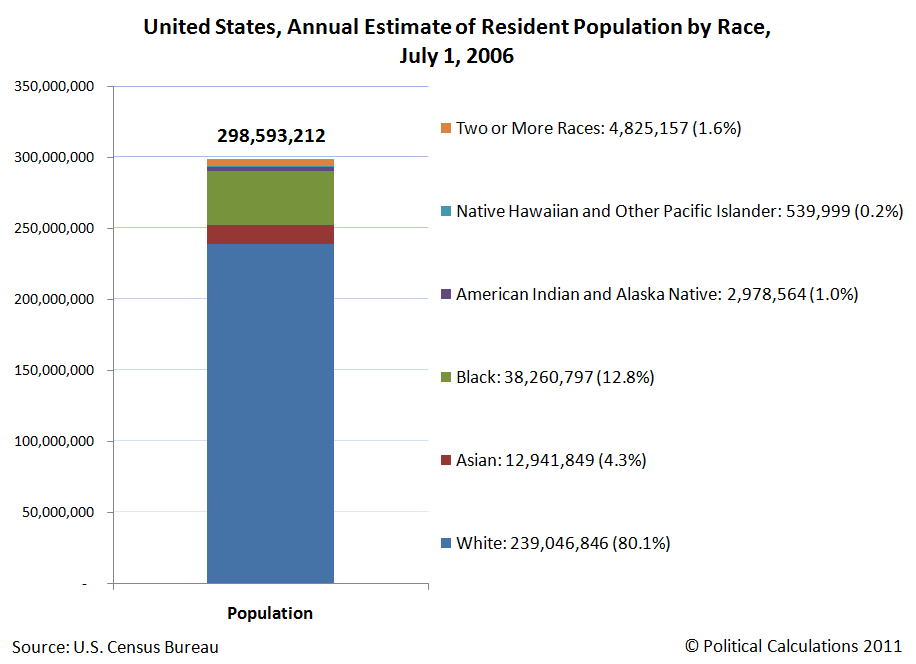
As you can see in our next chart showing the U.S. population breakdown just by race, that makes it difficult to directly compare the Canadian population with the U.S. population, which looks much less diverse by comparison (because of fewer categories), even though minorities make up a much larger relative share of the total population than does the visible minority population in Canada.
To address that seemingly simple representation of the U.S. population, we next broke each of the U.S. racial population categories to factor in the portion of each racial group who claim some degree of Hispanic origin.
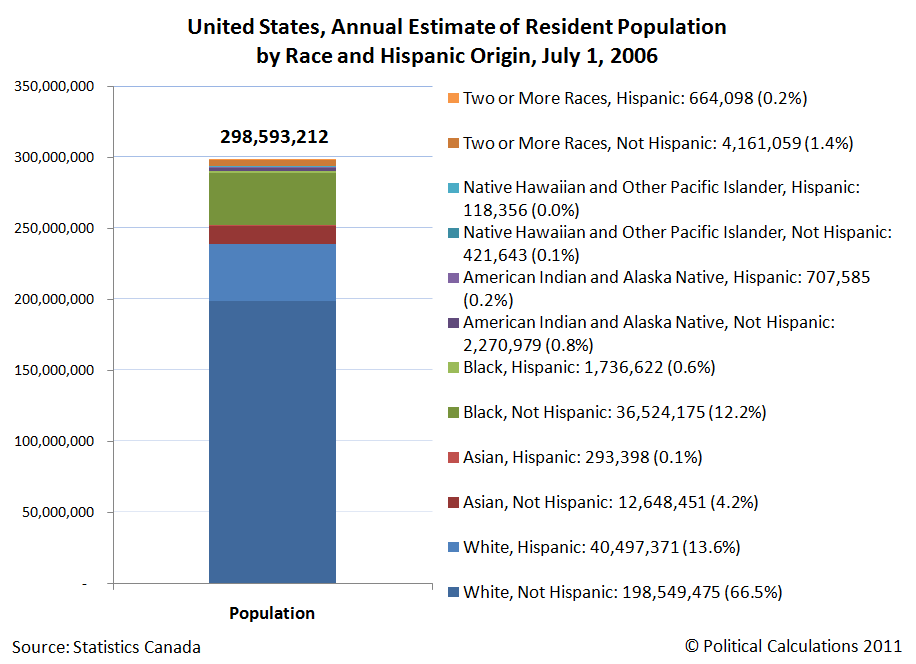
Once we break the data out this way, we find that segmenting the U.S. population like this shows that the U.S. population's diversity is at least on par with Canada's population, at least going by the number of categories.
However, except for very limited categories, we're still not able to directly compare the relative racial diversity of both nations, because so far, what we're really doing is an apples-to-oranges kind of comparison. Changing that to be a much better apples-to-apples kind of comparison will take some additional work....
Data Sources
Statistics Canada. 2006 Census. Visible Minority Population, by Province and Territory. Accessed 16 March 2011.
U.S. Census Bureau. Population Estimates. Annual Estimates of the Resident Population by Sex, Race, and Hispanic Origin for the United States: April 1, 2000 to July 1, 2009 (NC-EST2009-03). Accessed 16 March 2011.
Labels: data visualization, demographics
You might not have thought about it, but one of the biggest problems with compact fluorescent lamps (CFLs) is that unlike incandescent light bulbs, they just don't lend themselves to symbolic use as a metaphor for innovation. In fact, creativity expert and author of A Whack on the Side of the Head: How You Can Be More Creative Richard von Oech even offered a death notice for the light bulb's role in communicating new ideas:
Today, I'm announcing the death of a long time metaphor for creativity and innovation: the light bulb.
If you think about it, it's really quite amazing that a 125-year-old invention has had such longevity as a symbol for fresh thinking.
Imagine, for example, if the Long Play (LP) phonograph album (the 33 RPM version popularized in the 1950s) had become the metaphor for "new ideas." It would have been laughed out of existence no later than the early 1980s.
This hit home to me in a recent conversation I had with an art director with one of my publishers. We were reviewing cover mock-ups for one of my upcoming projects. One of them had a light bulb — symbolizing a "new idea."
I told her: "We can't use the light bulb for two reasons. First, it's a very, very, very old metaphor for a new idea. And second, the environmentalists are going to vilify the incandescent light bulb in coming years."
So long, trusty innovation metaphor. You served well! But it's time to find something new.
It's taken over three years since Roger first recognized the need for a new symbol for new ideas, but finally, Belarus-based industrial design firm Solovyovdesign rose to the occasion by re-imagining the original concept (via Core77):

If only CFL's themselves were as bright an idea as the illuminating and money-saving answer that they've been made out to be....
Labels: ideas, saving energy

In looking at the foreign ownership of the U.S. national debt, we realized that we could determine whether a nation is growing or fading in relative economic power by whether or not its share of the U.S. national debt is growing or falling with respect to other nations over time.
As you might imagine, a nation whose relative economic power is on the rise will see its share of the U.S. national debt it might own rise over time, which will most often be a result of it being able to run a trade surplus with the United States for a sustained period of time. Here, the nation running a sustained trade surplus would buy U.S. government-issued debt as a way to help balance the books for its international trade with the United States. The longer that goes on, the larger the share it gains of the U.S. national debt.
We found that that China and Brazil were the two nations whose relative economic power were on the rise during most of the first decade of the twenty-first century.
But in that analysis, we left out the nation whose relative economic power declined the most substantially by that measure - the United States!

You can begin seeing what we mean in our first chart, which adds the contributions from U.S. individuals and institutions, individuals such as people who own savings bonds, to institutions, which includes banks, private pension and retirement funds and the Federal Reserve, to the contributions of the U.S. Treasury "borrowing" money from other federal government entities, such as military and civilian government retirement funds and Social Security.
Here, we see that the relative amounts of the U.S. national debt owned by U.S. entities has not grown anywhere near as fast over much of the past decade as the portions owned by foreign powers.
That's especially true for U.S. government pension plans and Social Security, whose ownership of the U.S. national debt has grown at a steady pace over the past decade. By contrast, we see an explosion in the amount of U.S. debt held by all other entities, especially beginning after August 2008 as the financial crisis of that year began.
Our next chart maps the percentage share of the U.S. national debt for each of the indicated debt holders for each month from March 2000 through December 2010 (we're limited to only going back to March 2000 by the U.S. Treasury's available foreign-owned debt data. The percentages shown on the chart indicate each debt holders relative percentage share of the entire U.S. national debt in March 2000 and in December 2010.
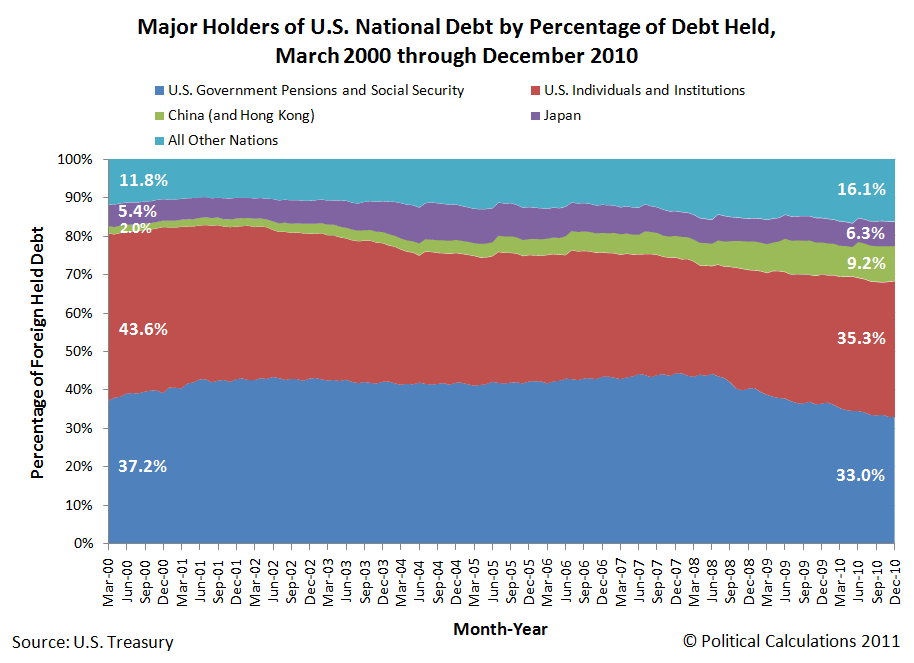
What we see here is that the portion of the U.S. national debt owned by U.S. persons and entities has fallen from the levels of March 2000, while the percentage share held by foreign entities has risen through December 2010. This outcome indicates that the relative economic power of the U.S. has slipped during the period from March 2000 through December 2010, and most dramatically following August 2008.
What's particularly disturbing is that the U.S. trade deficit with China has fallen since August 2008, which means that China's growing share of the U.S. national debt in the time since is not being driven by that nation's trade surplus with the United States and the need to balance the books of that international trade. Instead, it would appear that China's increasing ownership share of the U.S. national debt is aimed at effectively propping up the U.S. government and its spending.
Why China would desire to acquire U.S. debt in excess of what it would seem to need to balance its books to support its international trade is an exercise we'll leave to others. We'll simply observe that they likely believe the policy to be to their advantage in enhancing their relative status with respect to the United States, and so far, there are several indications that suggest that China's enhanced status is being recognized at the highest level.

Image Sources: The New Yorker via April Niemela and The Atlantic Council.
Labels: national debt, politics

Having looked at who the largest holders of the U.S. national debt were at the end of the 2010 U.S. government's fiscal year yesterday, we wondered if we could use some of that data to gain some insight into who the rising powers have been in the world over the past decade, as well as which nations have seen their power fade over that time. Here, it occurred to us that we could measure that change in relative power by seeing which nations used their growing economic strength to acquire larger and larger shares of the U.S. national debt.
So we mined the data the U.S. Treasury has on the foreign ownership of U.S. government-issued debt going back to March 2000 to find out.
Altogether, at the end of the U.S. government's fiscal year in 2010, non-U.S. entities owned 4.324 trillion dollars worth the U.S. government's total public debt outstanding, or rather, 31.9% of the $13.561 trillion that the U.S. government has borrowed from all sources to cover all of its spending through 30 September 2010. That figure represents 47.9% of the total amount of the debt held by the public at that time.
Here's how the the amount of debt held by the largest major foreign holders of the U.S. federal government's debt at the end its 2010 fiscal year has changed from March 2000 through December 2010:
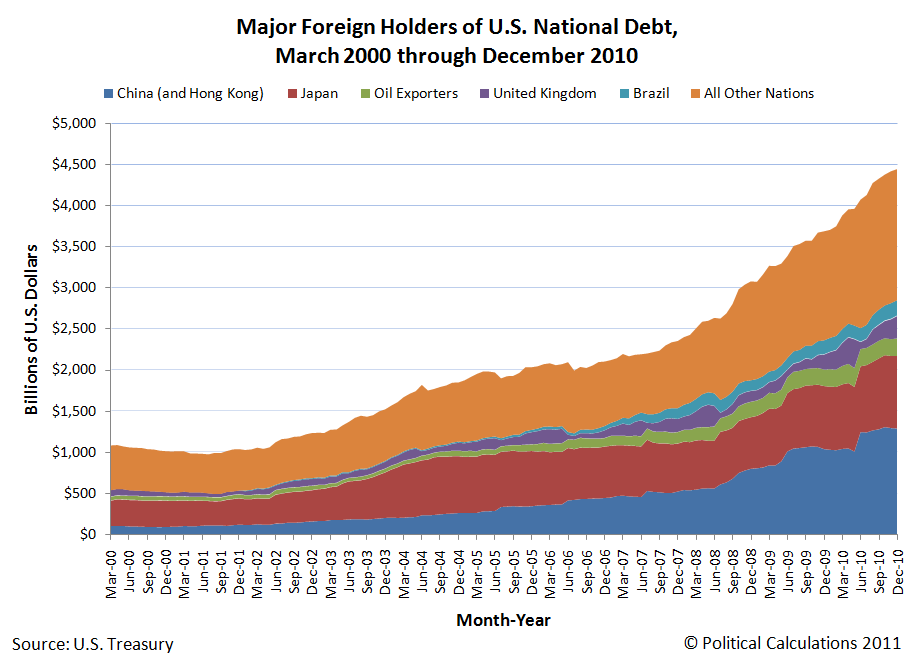
The largest foreign holders of the U.S. national debt on 30 September 2010 were China (mainland and Hong Kong), followed by Japan, "Oil Exporters", the United Kingdom and Brazil.
Let's next take a closer look at the relative percentage share of that foreign-held debt attributed to each of these nations has changed from March 2000 to December 2010:

What we find is that China's share of all the U.S. national debt held by foreign powers and institutions has risen from 10.2% in March 2000 to 29.2% in December 2010. Brazil's relative share of the total portion of the U.S. national debt held by foreign entities has grown from not being large enough to be specifically recorded in either 2000 and 2001 to 4.2% of all the U.S. government's foreign-held debt in December 2010.
Meanwhile, the relative shares for Japan, the United Kingdom, "Oil Exporters" and all other foreign nations has fallen. Japan saw the largest relative share decline for a single nation in going from holding 28.4% of U.S. government-issued debt in March 2010 to 19.9% in December 2010. All other foreign nations combined saw their relative share drop from 50.2% in March 2010 to 35.9% in December 2010.
Looking forward, given the magnitude of the earthquake and tsunami-related destruction in Japan, we should expect that the Japanese will act to cash in a good portion of their U.S. debt holdings to help raise the money that they'll need for recovery, which will further reduce that nation's share of U.S. government-issued debt.
Finally, there is a very large elephant in the room as to which nation has seen its relative share of the U.S. debt change the most over the past decade, which we've left out of this analysis and will get to soon....
Notes
"All Other Foreign Nations" are all those except China (for which we've included Hong Kong), Japan, United Kingdom, Brazil and "Oil Exporters."
"Oil exporters" include Ecuador, Venezuela, Indonesia, Bahrain, Iran, Iraq, Kuwait, Oman, Qatar, Saudi Arabia, the United Arab Emirates, Algeria, Gabon, Libya, and Nigeria.
Data Sources
U.S. Treasury Department. Monthly Statement of the Public Debt of the United States, September 30, 2010. Table III - Detail of Treasury Securities Outstanding, September 30, 2010.
U.S. Treasury Department. Major Foreign Holders of Treasury Securities. (December 2009 through December 2010). Accessed 11 March 2011.
U.S. Treasury Department. Major Foreign Holders of Treasury Securities (March 2000 through December 2009). Accessed 14 March 2011.
Labels: national debt
Back in January, we featured a post where we looked at just who are the largest holders of the U.S. national debt. Since that time, the U.S. Treasury has revised their data, specifically to identify who the real foreign owners of the U.S. national debt are. Here are how things really stood at the end of the U.S. government's 2010 fiscal year on September 30, 2010:

The main differences from the chart we previously featured are that China's holdings are much greater, while the United Kingdom's holdings are much smaller, which is a result of a number of Chinese institutions using banks in the United Kingdom as intermediaries for purchasing and holding U.S. government-issued debt. As a result, China's real U.S. debt holdings now account for 9.5% of the entire U.S. national debt outstanding (nearly 1 out of every 10 dollars the U.S. government has borrowed), instead of the 7.5% that was previously recorded.
Meanwhile, the U.K.'s recorded holdings have shrunk by a corresponding 2.0% of the entire U.S. national debt as a result of this accounting adjustment.
Finally, one question that came up after our original post was "How much of the national debt held by U.S. individuals and institutions is owned by the U.S. Federal Reserve?"
We found that as of September 29, 2010, the Federal Reserve held 966 billion dollars of the U.S. national debt in the form of U.S. Treasury Securities or Federal Agency Debt Securities, which represents 16.9% of all U.S. individual or institutional debt holdings, or approximately 7.1% of the total national debt.
So when it comes to who owns the U.S. national debt, the U.S. Federal Reserve owns less than China does....
Notes
"All Other Foreign Nations" are all those except China (for which we've included Hong Kong), Japan, United Kingdom, Brazil and "Oil Exporters."
"Oil exporters" include Ecuador, Venezuela, Indonesia, Bahrain, Iran, Iraq, Kuwait, Oman, Qatar, Saudi Arabia, the United Arab Emirates, Algeria, Gabon, Libya, and Nigeria.
The "U.S. Civil Service Retirement Fund" is the Federal Civil Service Retirement and Disability Fund. The "U.S. Military Retirement Fund" is the Department of Defense Retirement Fund. The "Social Security Trust Fund" is the Federal Old-Age Survivors and Disability Insurance Trust Fund.
Data Sources
U.S. Treasury Department. Monthly Statement of the Public Debt of the United States, September 30, 2010. Table III - Detail of Treasury Securities Outstanding, September 30, 2010.
U.S. Treasury Department. Major Foreign Holders of Treasury Securities. (At end of September 2010). Accessed 11 March 2011.
Board of Governors of the Federal Reserve System. Monthly Report on Credit and Liquidity Programs and the Balance Sheet, October 2010. Table 1. Assets, Liabilities, and Capital of the Federal Reserve System.
Labels: national debt
What is the stupidest thing that the U.S. federal government spent money on last year?

You don't have to be particularly partisan to realize that the potential list of really stupid things that the government spent money on last year is pretty long. After all, common sense alone should tell you that a not-so-small part of the $3,720,701,000,000 that the federal government projected it would spend in 2010 went to things that, on first glance, after a second look and even after a really long, detailed cost-benefit analysis, could have been spent more smartly.
Or perhaps even better, money that the government could have chosen to not spend at all! (We know, if only our elected officials would realize that's an option!...)
But how do we pick which federal spending line item was the most stupid thing for the federal government to spend money on in 2010?
We started by looking at things that the federal government spent money on in the last year that, by all objective standards, failed to achieve their stated goals. Namely, we looked at things that were part of the American Recovery and Reinvestment Act of 2009, aka "The Stimulus Bill", aka "The Stimulus Package", which was intended to create permanent jobs in both 2009 and 2010, and which is widely recognized by the public to have failed.
We then looked at spending line items whose cost exceeded at least $31,000, which we'll use as a reference point for all these stupid spending projects.
Why $31,000? As it happens, that's approximately the amount of money the federal government projected it would spend per U.S. household in 2010. More importantly, we can use that figure to estimate how many households could have been spared the burden of the federal government's most stupid spending if only the federal government had just shown some restraint.

So which part of the 2009 Stimulus Package was the stupidest thing that the federal government funded in 2010?
In our opinion, it was perhaps a little construction project we'll call "The Sidewalk to Nowhere".
This federal government-funded construction project only cost U.S. taxpayers $89,298, but somehow managed to neither create any permanent jobs nor did it provide any meaningful benefits for the citizens of the community it served!
That community is Boynton, Oklahoma, where the federal government funded a project to replace a quarter-mile long sidewalk that had itself just been replaced five years earlier. The fully repaved stretch of sidewalk would then fully comply with the federal sidewalk guidelines dictated by the Americans with Disabilities Act (ADA).
But don't take our word for it. Here are the before and after pictures of the project, which clearly shows the magnitude of the federal government's achievement in bringing the full quarter-mile length of the sidewalk into full compliance with the ADA:

Now, aside from the idea that the federal government apparently has specifically dedicated funding and personnel for the purpose of developing design and construction guidelines for sidewalks, which itself means that there's probably a federal sidewalk inspector on the federal payroll to enforce them, the $89,298 that was spent on this specific boondoggle could have spared the equivalent of nearly three American households from being excessively burdened by mindless federal spending, but that weren't.
That may not seem like much money, at least until you consider the possibility that one of those three households could have been yours.
So why do we call it the "Sidewalk to Nowhere"? Truth be told, that's just a bit of creative license on our part, because in reality, the "Sidewalk to Nowhere" really does go somewhere. It leads past a vacant lot straight to a ditch.

Perhaps this is the previously missing feature that now makes the sidewalk fully comply with the federal Americans with Disabilities Act. Thanks to your tax dollars at work, the disabled can now much more easily access the ditch at the end of the "Sidewalk to Nowhere" in Boynton, Oklahoma, where many citizens really can't believe that someone actually made a federal case out of repaving one of their sidewalks to specifically provide this kind of unparalleled access for the disabled to what is perhaps the town's least well-known natural amenity.
No, we can't make these things up. Except maybe the part about the federal sidewalk inspector. We really don't know if there is one or not!...
References
Oklahoma Department of Transportation. ARRA Project Information. May 5, 2010.
Cameron, Alex. "Some Muskogee County Residents Angered Over Stimulus Funding For Sidewalk". NewsOn6.com. April 13, 2010.
Labels: national debt
Welcome to the blogosphere's toolchest! Here, unlike other blogs dedicated to analyzing current events, we create easy-to-use, simple tools to do the math related to them so you can get in on the action too! If you would like to learn more about these tools, or if you would like to contribute ideas to develop for this blog, please e-mail us at:
ironman at politicalcalculations
Thanks in advance!
Closing values for previous trading day.
This site is primarily powered by:
CSS Validation
RSS Site Feed
JavaScript
The tools on this site are built using JavaScript. If you would like to learn more, one of the best free resources on the web is available at W3Schools.com.

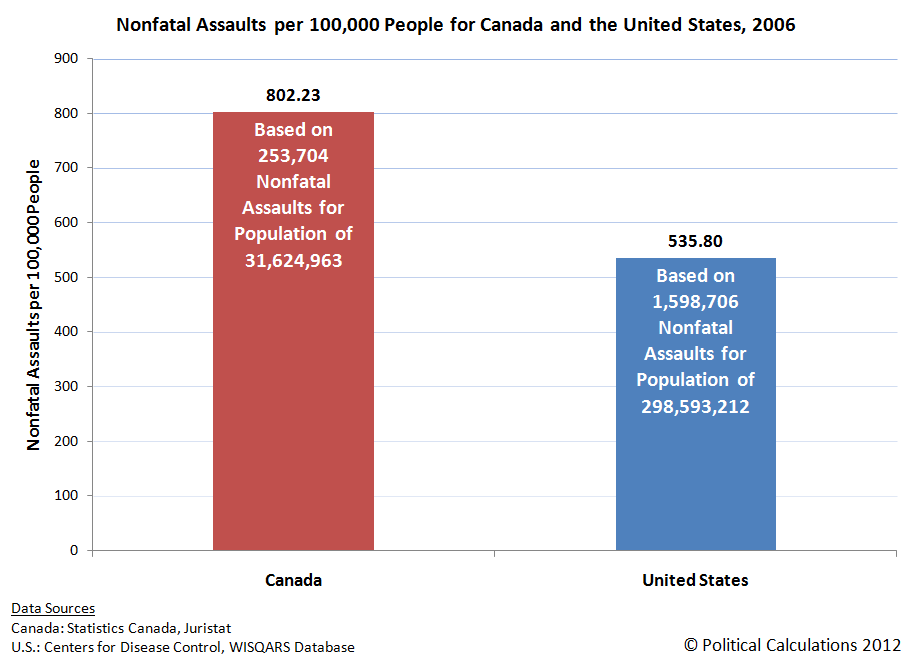


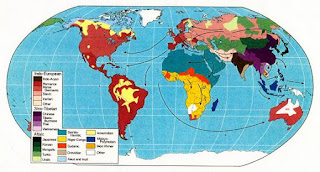
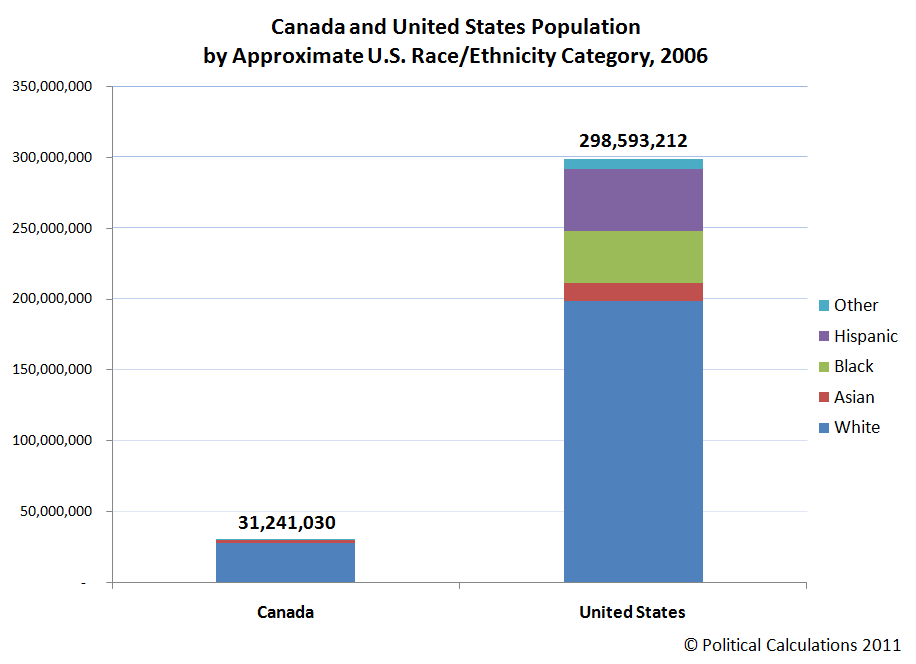

![Canada and United States Resident Population by Approximate U.S. Race Category, Minus Black and Hispanic Population, 2006 [Corrected] Canada and United States Resident Population by Approximate U.S. Race Category, Minus Black and Hispanic Population, 2006 [Corrected]](https://blogger.googleusercontent.com/img/b/R29vZ2xl/AVvXsEg6OjKPZTw93BlRw_jKVyJbk_-xqynAataTipSb6d204inMwKj1NFyxAE3tXexjguHx7HoT0ScqlSVrT6ZRJtNAe1HLi35j_xPc-yShZd6AQPWugiCv63SxzA0enSUF8p-cAdNsPg/s1600/Canada-and-US-resident-population-by-approximate-US-race-category-minus-black-and-hispanic-population-2006.png)